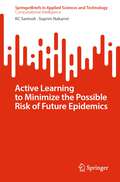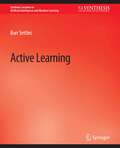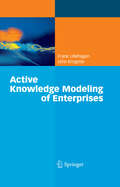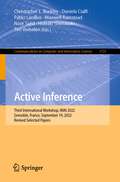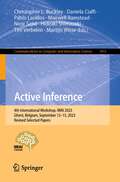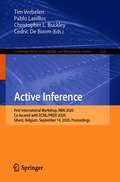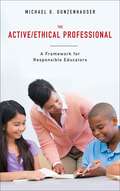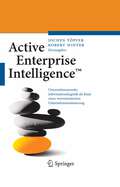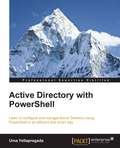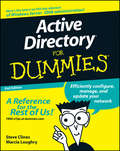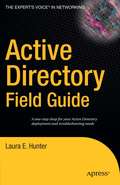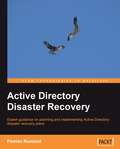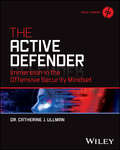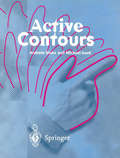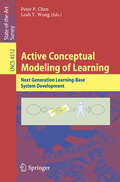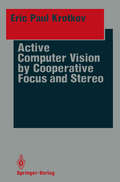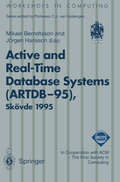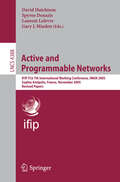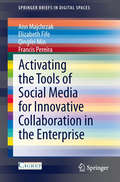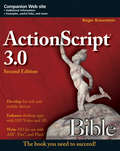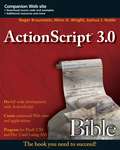- Table View
- List View
Active Learning to Minimize the Possible Risk of Future Epidemics (SpringerBriefs in Applied Sciences and Technology)
by KC Santosh Suprim NakarmiFuture epidemics are inevitable, and it takes months and even years to collect fully annotated data. The sheer magnitude of data required for machine learning algorithms, spanning both shallow and deep structures, raises a fundamental question: how big data is big enough to effectively tackle future epidemics? In this context, active learning, often referred to as human or expert-in-the-loop learning, becomes imperative, enabling machines to commence learning from day one with minimal labeled data. In unsupervised learning, the focus shifts toward constructing advanced machine learning models like deep structured networks that autonomously learn over time, with human or expert intervention only when errors occur and for limited data—a process we term mentoring. In the context of Covid-19, this book explores the use of deep features to classify data into two clusters (0/1: Covid-19/non-Covid-19) across three distinct datasets: cough sound, Computed Tomography (CT) scan, and chest x-ray (CXR). Not to be confused, our primary objective is to provide a strong assertion on how active learning could potentially be used to predict disease from any upcoming epidemics. Upon request (education/training purpose), GitHub source codes are provided.
Active Learning (Synthesis Lectures on Artificial Intelligence and Machine Learning)
by Burr ChenThe key idea behind active learning is that a machine learning algorithm can perform better with less training if it is allowed to choose the data from which it learns. An active learner may pose "queries," usually in the form of unlabeled data instances to be labeled by an "oracle" (e.g., a human annotator) that already understands the nature of the problem. This sort of approach is well-motivated in many modern machine learning and data mining applications, where unlabeled data may be abundant or easy to come by, but training labels are difficult, time-consuming, or expensive to obtain. This book is a general introduction to active learning. It outlines several scenarios in which queries might be formulated, and details many query selection algorithms which have been organized into four broad categories, or "query selection frameworks." We also touch on some of the theoretical foundations of active learning, and conclude with an overview of the strengths and weaknesses of these approaches in practice, including a summary of ongoing work to address these open challenges and opportunities. Table of Contents: Automating Inquiry / Uncertainty Sampling / Searching Through the Hypothesis Space / Minimizing Expected Error and Variance / Exploiting Structure in Data / Theory / Practical Considerations
Active Knowledge Modeling of Enterprises
by Frank Lillehagen John KrogstieEnterprise Modeling has been defined as the art of externalizing enterprise knowledge, i.e., representing the core knowledge of the enterprise. Although useful in product design and systems development, for modeling and model-based approaches to have a more profound effect, a shift in modeling approaches and methodologies is necessary. Modeling should become as natural as drawing, sketching and scribbling, and should provide powerful services for capturing work-centric, work-supporting and generative knowledge, for preserving context and ensuring reuse. A solution is the application of Active Knowledge Modeling (AKM). The AKM technology is about discovering, externalizing, expressing, representing, sharing, exploring, configuring, activating, growing and managing enterprise knowledge. An AKM solution is about exploiting the Web as a knowledge engineering medium, and developing knowledge-model-based families of platforms, model-configured workplaces and services. This book was written by the inventors of AKM arising out of their cooperation with both scientists and industrial practitioners over a long period of time, and the authors give examples, directions, methods and services to enable new ways of working, exploiting the AKM approach to enable effective c-business, enterprise design and development, and lifecycle management. Industry managers and design engineers will become aware of the manifold possibilities of, and added values in, IT-supported distributed design processes, and researchers for collaborative design environments will find lots of stimulation and many examples for future developments.
Active Inference: Third International Workshop, IWAI 2022, Grenoble, France, September 19, 2022, Revised Selected Papers (Communications in Computer and Information Science #1721)
by Christopher L. Buckley Daniela Cialfi Pablo Lanillos Maxwell Ramstead Noor Sajid Hideaki Shimazaki Tim VerbelenThis volume constitutes the papers of the 3rd International Workshop on Active Inference, IWAI 2022, held in Grenoble, France, in conjunction with ECML/PKDD, on September 19, 2022.The 25 revised full papers presented in this book were carefully reviewed and selected from 31 submissions.
Active Inference: 4th International Workshop, IWAI 2023, Ghent, Belgium, September 13–15, 2023, Revised Selected Papers (Communications in Computer and Information Science #1915)
by Christopher L. Buckley Daniela Cialfi Pablo Lanillos Maxwell Ramstead Noor Sajid Hideaki Shimazaki Tim Verbelen Martijn WisseThis volume constitutes the papers of the 4th International Workshop on Active Inference, IWAI 2023, held in Ghent, Belgium on September 2023.The 17 full papers included in this book were carefully reviewed and selected from 34 submissions. They were organized in topical sections as follows: active inference and robotics; decision-making and control; active inference and psychology; from theory to implementation; learning representations for active inference; and theory of learning and inference.
Active Inference: First International Workshop, IWAI 2020, Co-located with ECML/PKDD 2020, Ghent, Belgium, September 14, 2020, Proceedings (Communications in Computer and Information Science #1326)
by Tim Verbelen Pablo Lanillos Christopher L. Buckley Cedric De BoomThis book constitutes the refereed proceedings of the First International Workshop on Active Inference, IWAI 2020, co-located with ECML/PKDD 2020, held in Ghent, Belgium, in September 2020. The 13 full papers along with 6 short papers were thoroughly reviewed and selected from 25 submissions. They are organized in the topical sections on active inference and continuous control; active inference and machine learning; active inference: theory and biology.
The Active/Ethical Professional: A Framework for Responsible Educators
by Michael G. GunzenhauserThe Active/Ethical Professional proposes an ethical framework for educators and school leaders who find their practice constrained by the demands of policies and structures created in response to accountability legislation. The framework is derived from Michel Foucault's theories of discipline, surveillance, resistance, and care of the self. Gunzenhauser asserts that an educator's dual position of being normalized (especially in relations with those above them in the education hierarchy) and normalizing (especially in relations with their students) can be troubling and difficult. The book argues that this position requires educators to be both "ethical" and "active." To be ethical, educators not only need to resolve ethical dilemmas in defensible ways, but they also need to recognize themselves as powerful in relation to others. To be active, educators need to be vigilant for moments when they are placed in the position to be "reactive" to normalizing pressures, and they also need to develop clear notions of how they may create opportunities for the cultivation of educational selves - selves that are rich ethically, aesthetically, epistemologically, and politically.
The Active/Ethical Professional: A Framework for Responsible Educators
by Michael G. GunzenhauserThe Active/Ethical Professional proposes an ethical framework for educators and school leaders who find their practice constrained by the demands of policies and structures created in response to accountability legislation. The framework is derived from Michel Foucault's theories of discipline, surveillance, resistance, and care of the self. Gunzenhauser asserts that an educator's dual position of being normalized (especially in relations with those above them in the education hierarchy) and normalizing (especially in relations with their students) can be troubling and difficult. The book argues that this position requires educators to be both "ethical" and "active." To be ethical, educators not only need to resolve ethical dilemmas in defensible ways, but they also need to recognize themselves as powerful in relation to others. To be active, educators need to be vigilant for moments when they are placed in the position to be "reactive" to normalizing pressures, and they also need to develop clear notions of how they may create opportunities for the cultivation of educational selves - selves that are rich ethically, aesthetically, epistemologically, and politically.
Active Enterprise Intelligence™: Unternehmensweite Informationslogistik als Basis einer wertorientierten Unternehmenssteuerung
by Jochen Töpfer Robert WinterActive Enterprise Intelligence ist der ganzheitliche Ansatz einer Informationslogistik von Teradata, der zwischen Strategic und Operational Intelligence unterscheidet, diese aber in einer integrierten Betrachtungsweise auf Basis eines unternehmensweiten Active Data Warehouses wieder zusammenführt. Dieses Buch verbindet erstmals den Teradata-Ansatz mit der St. Galler Schule der Unternehmensweiten Informationslogistik. Aktuelle Herausforderungen und Lösungsansätze der Informationslogistik werden thematisiert und Hinweise zu ihrer Ausgestaltung gegeben.
Active Directory with PowerShell
by Uma YellapragadaIf you are looking to automate repetitive tasks in Active Directory management using the PowerShell module, then this book is for you. Any experience in PowerShell would be an added advantage.
Active Directory For Dummies
by Steve Clines Marcia LoughryWhether you’re new to Active Directory (AD) or a savvy system administrator looking to brush up on your skills, Active Directory for Dummies, 2nd Edition will steer you in the right direction! Since its original release, Microsoft’s implementation of the lightweight directory access protocol (LDAP) for the Windows Server line of networking software has become one of the most popular directory service products in the world. If you are involved with the design and support of Microsoft directory services and/or solutions, you really need this book! You’ll understand the basics of AD and utilize its structures to simplify your life and secure your digital environment. You’ll discover how to exert fine-grained control over groups, assets, security, permissions, and policies on a Windows network and efficiently configure, manage, and update the network. You’ll find new and updated material on security improvements, significant user interface changes, and updates to the AD scripting engine, password policies, accidental object deletion protection, and more. You will learn how to: Navigate the functions and structures of AD Understand business and technical requirements and determine goals Become familiar with physical components like site links, network services, and site topology Manage and monitor new features, AD replication, and schema management Maintain AD databases Avoid common AD mistakes that can undermine network security Complete with lists of the ten most important points about AD, and ten cool Web resources, and ten troubleshooting tips, Active Directory For Dummies, 2nd Edition is your one-stop guide to setting up, working with, and making the most of Active Directory. Note: CD-ROM/DVD and other supplementary materials are not included as part of eBook file.
Active Directory For Dummies
by Steve Clines Marcia LoughryWhether you’re new to Active Directory (AD) or a savvy system administrator looking to brush up on your skills, Active Directory for Dummies, 2nd Edition will steer you in the right direction! Since its original release, Microsoft’s implementation of the lightweight directory access protocol (LDAP) for the Windows Server line of networking software has become one of the most popular directory service products in the world. If you are involved with the design and support of Microsoft directory services and/or solutions, you really need this book! You’ll understand the basics of AD and utilize its structures to simplify your life and secure your digital environment. You’ll discover how to exert fine-grained control over groups, assets, security, permissions, and policies on a Windows network and efficiently configure, manage, and update the network. You’ll find new and updated material on security improvements, significant user interface changes, and updates to the AD scripting engine, password policies, accidental object deletion protection, and more. You will learn how to: Navigate the functions and structures of AD Understand business and technical requirements and determine goals Become familiar with physical components like site links, network services, and site topology Manage and monitor new features, AD replication, and schema management Maintain AD databases Avoid common AD mistakes that can undermine network security Complete with lists of the ten most important points about AD, and ten cool Web resources, and ten troubleshooting tips, Active Directory For Dummies, 2nd Edition is your one-stop guide to setting up, working with, and making the most of Active Directory. Note: CD-ROM/DVD and other supplementary materials are not included as part of eBook file.
Active Directory Field Guide
by Beau Hunter* Task-based, advanced solutions * Discusses non-traditional or out-of-band solutions * Written from real-world knowledge * Focuses on solutions relevant to consultants
Active Directory Disaster Recovery: Expert Guidance On Planning And Implementing Active Directory Disaster Recovery Plans
by Florian RommelThe book is a combined planning/response-focused book and can be read end to end but also is designed so that the second half can be read standalone, should disaster have struck already. This book is targeted at network security professionals who find themselves charged with creating an Active Directory Disaster Recovery plan or who want to quickly recover once disaster has struck. This book expects you to be familiar with the basics of Active Directory and Windows Servers.
The Active Defender: Immersion in the Offensive Security Mindset
by Dr. Catherine J. UllmanImmerse yourself in the offensive security mindset to better defend against attacks In The Active Defender: Immersion in the Offensive Security Mindset, Senior Information Security Forensic Analyst Dr. Catherine J. Ullman delivers an expert treatment of the Active Defender approach to information security. In the book, you’ll learn to understand and embrace the knowledge you can gain from the offensive security community. You’ll become familiar with the hacker mindset, which allows you to gain emergent insight into how attackers operate and better grasp the nature of the risks and threats in your environment. The author immerses you in the hacker mindset and the offensive security culture to better prepare you to defend against threats of all kinds. You’ll also find: Explanations of what an Active Defender is and how that differs from traditional defense models Reasons why thinking like a hacker makes you a better defender Ways to begin your journey as an Active Defender and leverage the hacker mindsetAn insightful and original book representing a new and effective approach to cybersecurity, The Active Defender will be of significant benefit to information security professionals, system administrators, network administrators, and other tech professionals with an interest or stake in their organization’s information security.
The Active Defender: Immersion in the Offensive Security Mindset
by Dr. Catherine J. UllmanImmerse yourself in the offensive security mindset to better defend against attacks In The Active Defender: Immersion in the Offensive Security Mindset, Senior Information Security Forensic Analyst Dr. Catherine J. Ullman delivers an expert treatment of the Active Defender approach to information security. In the book, you’ll learn to understand and embrace the knowledge you can gain from the offensive security community. You’ll become familiar with the hacker mindset, which allows you to gain emergent insight into how attackers operate and better grasp the nature of the risks and threats in your environment. The author immerses you in the hacker mindset and the offensive security culture to better prepare you to defend against threats of all kinds. You’ll also find: Explanations of what an Active Defender is and how that differs from traditional defense models Reasons why thinking like a hacker makes you a better defender Ways to begin your journey as an Active Defender and leverage the hacker mindsetAn insightful and original book representing a new and effective approach to cybersecurity, The Active Defender will be of significant benefit to information security professionals, system administrators, network administrators, and other tech professionals with an interest or stake in their organization’s information security.
Active Contours: The Application of Techniques from Graphics, Vision, Control Theory and Statistics to Visual Tracking of Shapes in Motion
by Andrew Blake Michael IsardActive Contours deals with the analysis of moving images - a topic of growing importance within the computer graphics industry. In particular it is concerned with understanding, specifying and learning prior models of varying strength and applying them to dynamic contours. Its aim is to develop and analyse these modelling tools in depth and within a consistent framework.
Active Conceptual Modeling of Learning: Next Generation Learning-Base System Development (Lecture Notes in Computer Science #4512)
by Peter P. Chen Leah Y. WongThis volume is a collection of papers presented during the first International ACM-L Workshop, which was held in Tucson, Arizona, during the 25th International Conference on Conceptual Modeling, ER 2006. Included in this state-of-the-art survey are 11 revised full papers, carefully reviewed and selected from the workshop presentations. These are rounded off with four invited lectures and an introductory overview, and represent the current thinking in conceptual modeling research.
Active Computer Vision by Cooperative Focus and Stereo (Springer Series in Perception Engineering)
by Eric P. KrotkovThis book addresses an area of perception engineering which deals with constructive processes. A model of the environment is analyzed using the information acquired from mUltiple viewpoints of multiple disparate sensors at multiple time instants. Although the role of successive model building and active exploration of the environment, as is discussed in this book, is of great importance, only a few researchers of machine perception have thus far addressed the problem in these directions. Krotkov's book, which is a modification and continuation of his highly successful dissertation, focuses on active exploratory sensing in the context of spatial layout perception. He uses stereo and focus to obtain distance By information, and to eventually develop cooperative combining techniques. means of a stereo system with verging cameras, it is demonstrated that the distance measurements can be significantly improved by combining two sources. In addition, the problem of merging information from the multiple views is discussed in detail. As the field of perception engineering seems to be of growing scientific and applied importance, both practitioners and researchers in machine perception will find this book a valuable addition to their libraries. RameshJain Series Editor Acknowledgements I would like to thank Professor Ruzena Bajcsy for her constant encouragement and guidance during the five years of research leading to the dissertation upon which this book is based. Without her help in all matters, this work would never have been possible.
Active and Real-Time Database Systems: Proceedings of the First International Workshop on Active and Real-Time Database Systems, Skövde, Sweden, 9–11 June 1995 (Workshops in Computing)
by Mikael Berndtsson Jörgen HanssonThe areas of active and real-time databases have seen a tremendous growth of interest in the past few years, particularly with regard to their support of time-critical and embedded applications. ARTDB-95 provided, therefore, an important forum for researchers from both communities to discuss research results, and also to chart new directions for the future. As well as the 11 submitted papers presented at the workshop, this volume also contains 4 invited papers on the following topics: the impact of active databases on commercial practice; the optimization of active database transactions; the need for better language, compiler and tool support for real-time databases; and the origin of time constraints associated with data, events and actions. Together the papers give a comprehensive overview of current research, and will provide invaluable reading for academic and industrial researchers and students at both undergraduate and postgraduate level.
Active and Programmable Networks: IFIP TC6 7th International Working Conference, IWAN 2005, Sophia Antipolis, France, November 21-23, 2005, Revised Papers (Lecture Notes in Computer Science #4388)
by David Hutchison Spyros Denazis Laurent Lefevre Gary J. MindenThis volume contains the proceedings of the 7th International Working Conference on Active and Programmable Networks (IWAN 2005) that was held during November 21–23, 2005, in Sophia Antipolis, Cote d’ Azur, France, jointly organized by Hitachi Europe and INRIA. IWAN 2005 took place against a backdrop of questions about the viability and - cessity of a conference that deals with an area perceived by many as having run its full course. The Organizing Committee, during the preparations of the conference, took these concerns seriously and reflected them in the theme of this year’s event, entitled “Re-incarnating Active Networking Research,” and expanding the scope of past calls for papers into topics that have emerged from active and programmable networks. The result was a success because we received 72 submissions, a number that - ceeded our expectations and in fact is one of the highest in the history of the conf- ence. The distinguished Technical Program Committee set high standards for the final program; each one of the submitted papers received three peer reviews with detailed comments and suggestions for the authors. In total, 13 papers were accepted for the main program sessions with 9 papers accepted unconditionally and the remaining 4 papers being conditionally accepted with shepherding by selected Program Committee members.
Activating the Tools of Social Media for Innovative Collaboration in the Enterprise (SpringerBriefs in Digital Spaces)
by Ann Majchrzak Elizabeth Fife Qingfei Min Francis PereiraThe use of social media tools in the enterprise is expanding rapidly and yet, firms are still unclear about the overall value of this activity and how best to facilitate useful outcomes. The focus of this book is, from a managerial standpoint, the control of information, the extent to which such tools can enhance employee satisfaction and how best to use social media tools to attain specific outcomes including innovative collaboration. As companies turn to IT solutions as substitutes for face-to-face engagements, an understanding of the social dynamics – how employees can best communicate, find and use information and generate motivation through computer-mediated activities is fundamental. Lingering questions relate to the strategic use of these tools; many large companies are using Facebook-like applications due to employee demand, but are not studying outcomes comprehensively or managing processes to create desired outcomes. This book fills this knowledge gap through examining the process and results of a controlled study in two companies, one in the US and the other in China. In each company “wiki challenges” were introduced to employees who were provided guidelines to produce goal-oriented outcomes. The book examine the results in each case and suggest guidelines for firms to achieve “wiki-readiness” to support innovation and co-creation.
ActionScript 3.0 Bible (Bible #617)
by Roger BraunsteinThe updated edition on all the latest features and capabilities of ActionScript 3.0 and Flash Player 10. ActionScript is a popular programming language used primarily for the development of Web sites and software. This update to the successful previous version introduces you to all the exciting new capabilities of ActionScript 3.0. You'll see how ActionScript 3.0 goes beyond its primary use of scripting Flash animations and is now an object-oriented evolution that runs ten times faster than previous versions and can be used in Adobe's new platforms, including Flex and AIR. Hands-on instruction and step-by-step tutorials enhance your learning process as you discover everything you need to know in order to harness the power of ActionScript 3.0. You'll learn the nitty gritty of building Rich Internet Applications (RIA) and the ins and outs of putting the new features of ActionScript 3.0 to work for you. ActionScript 3.0 goes beyond its original role as a scripting language and has added development features, incredible speed, and the ability to work with Flex and AIR Shows you how to apply advanced graphic effects using Pixel Blender Demonstrates the all-new text and typography capabilities Addresses your new enhanced control over dynamic sound Explains templated types and new vector data structures ActionScript 3.0 Bible offers you a soup-to-nuts guide on all things ActionScript 3.0 so you can get started working with it immediately.
ActionScript 3.0 Bible (Bible #617)
by Roger BraunsteinThe updated edition on all the latest features and capabilities of ActionScript 3.0 and Flash Player 10. ActionScript is a popular programming language used primarily for the development of Web sites and software. This update to the successful previous version introduces you to all the exciting new capabilities of ActionScript 3.0. You'll see how ActionScript 3.0 goes beyond its primary use of scripting Flash animations and is now an object-oriented evolution that runs ten times faster than previous versions and can be used in Adobe's new platforms, including Flex and AIR. Hands-on instruction and step-by-step tutorials enhance your learning process as you discover everything you need to know in order to harness the power of ActionScript 3.0. You'll learn the nitty gritty of building Rich Internet Applications (RIA) and the ins and outs of putting the new features of ActionScript 3.0 to work for you. ActionScript 3.0 goes beyond its original role as a scripting language and has added development features, incredible speed, and the ability to work with Flex and AIR Shows you how to apply advanced graphic effects using Pixel Blender Demonstrates the all-new text and typography capabilities Addresses your new enhanced control over dynamic sound Explains templated types and new vector data structures ActionScript 3.0 Bible offers you a soup-to-nuts guide on all things ActionScript 3.0 so you can get started working with it immediately.
ActionScript 3.0 Bible (Bible #433)
by Roger Braunstein Mims H. Wright Josuha J. NobleThis description refers to the first edition of ActionScript 3.0 Bible. For the greatly revised and updated second edition published in April 2010, search on author Roger Braunstein’s name or for ISBN 0470525231. ActionScript has matured into a full-fledged, object-oriented programming language for creating cutting-edge Web applications, and this comprehensive book is just what you need to succeed. If you want to add interactivity to Flash, build Flex applications, or work with animation — it's all here, and more. Packed with clear instruction, step-by-step tutorials, and advanced techniques, this book is your go-to guide to unlock the power of this amazing language. Learn the basics, apply object-oriented programming, and more.
